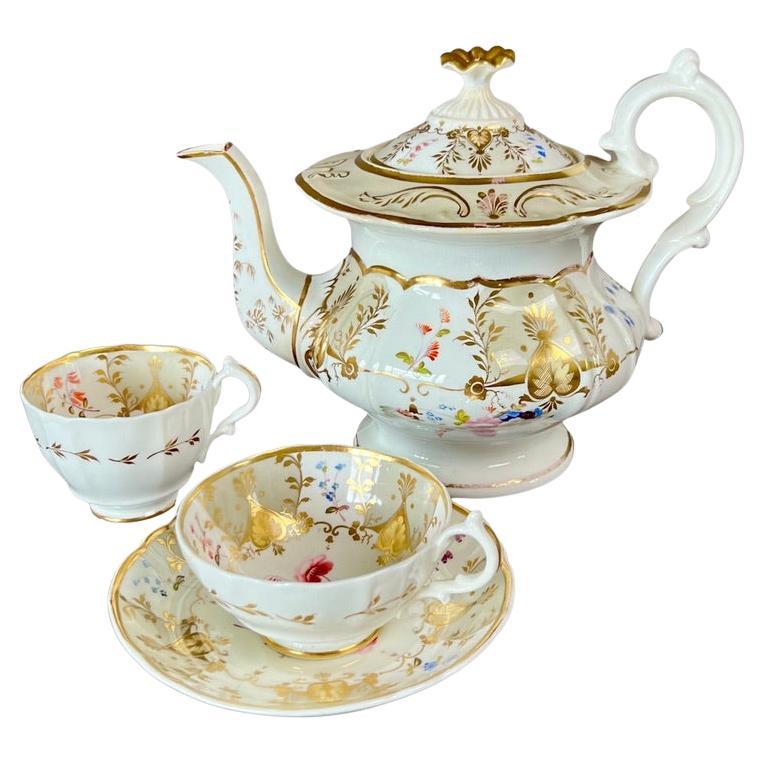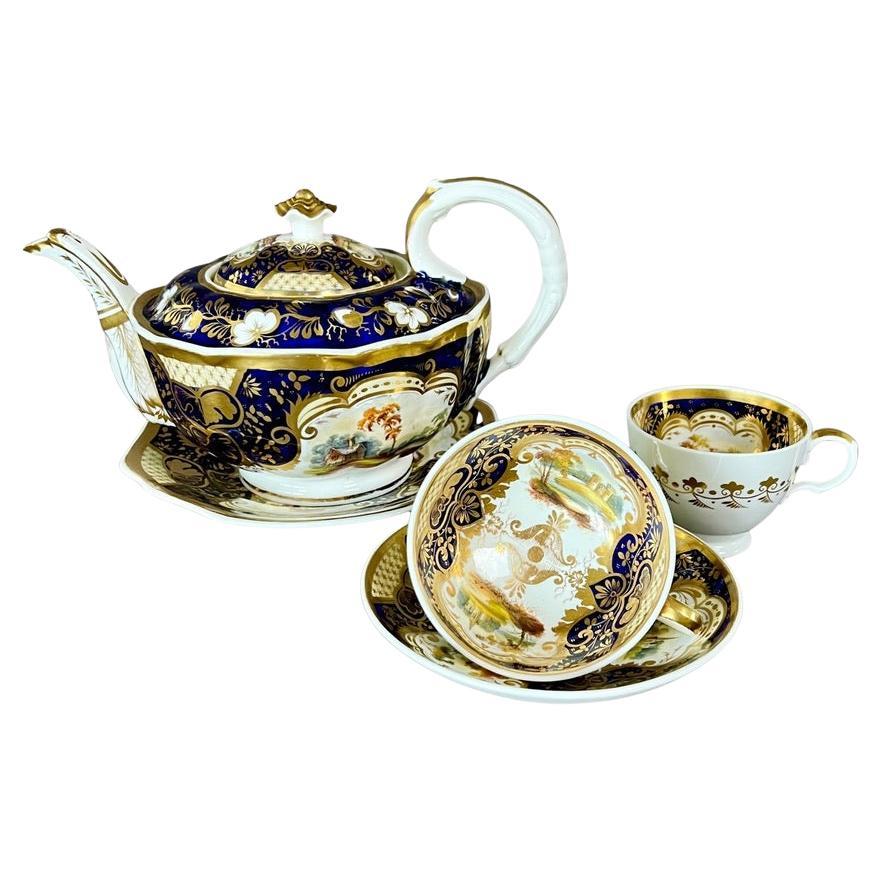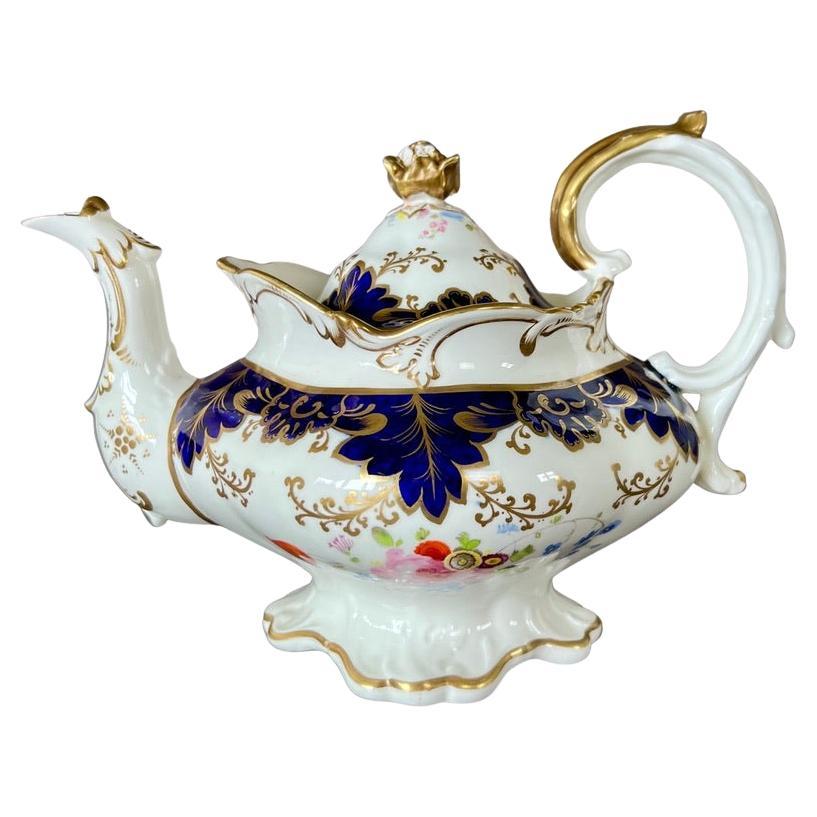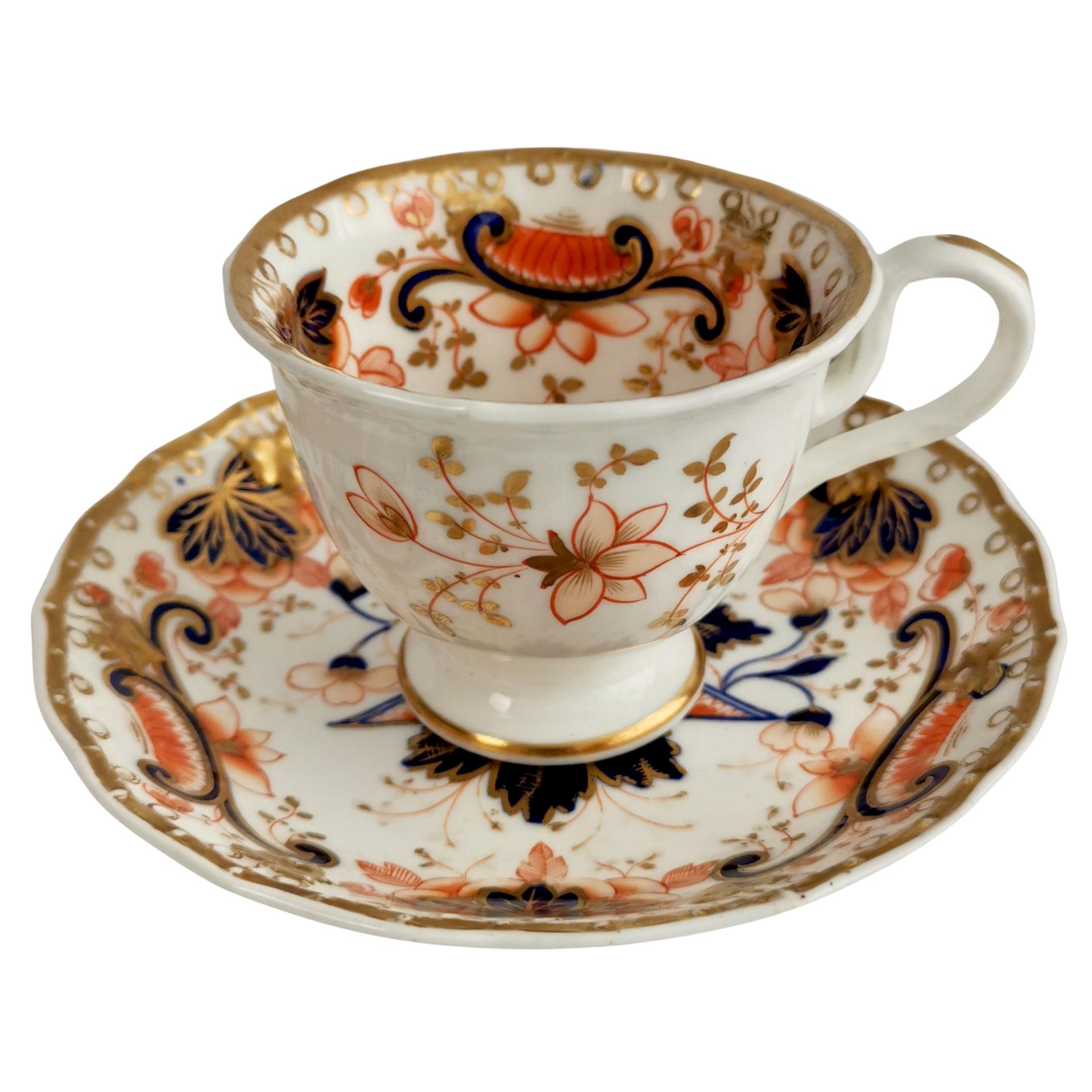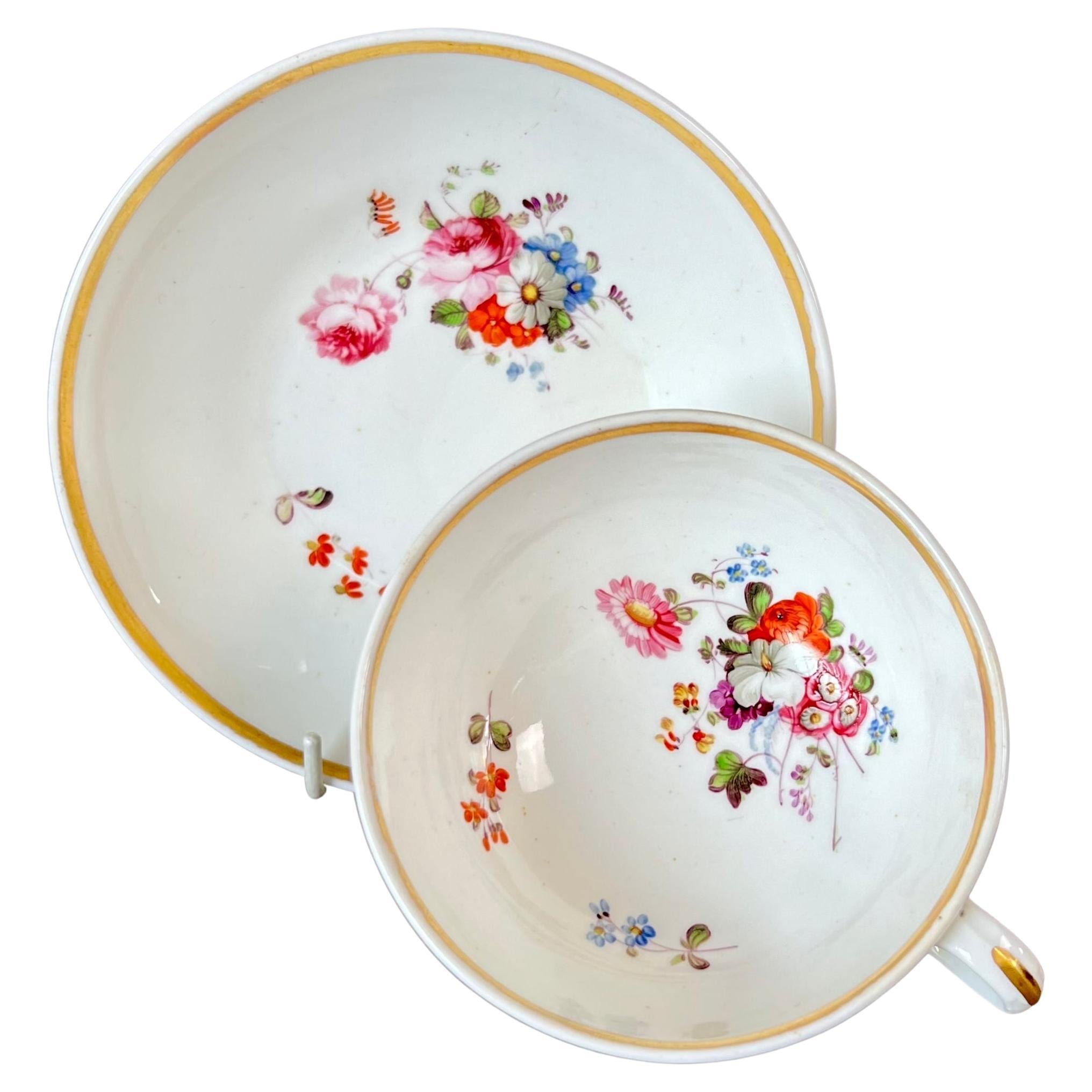Items Similar to Samuel Alcock Matched Solitaire Porcelain Tea Set, Pink with Flowers, ca 1836
Want more images or videos?
Request additional images or videos from the seller
1 of 17
Samuel Alcock Matched Solitaire Porcelain Tea Set, Pink with Flowers, ca 1836
About the Item
A matched solitaire tea set consisting of a teapot with cover, a sucrier with cover, a milk jug and a matched trio consisting of a teacup, a coffee cup and a saucer. With pink ground and looping vines, and hand painted flowers
Patterns 1/6600 and 1/9821
Year: ca 1836
Size: teapot 26cm (10.25”) from handle to spout
Condition: teapot has one foot replaced, repair to sucrier, some minor rubbing and crazing, but still suitable for use
This service forms part of the Murray Pollinger Collection of Samuel Alcock Porcelain.
Murray Pollinger was a passionate collector of Samuel Alcock porcelain. He was known as a true gentleman, impeccably dressed, always kind and modest - even some of his porcelain collecting friends had no idea about the size and importance of his collection. From the mid 1980s until shortly before his death in 2022 he collected many thousands of pieces and painstakingly catalogued them. He also went on trips to Staffordshire to discover the history of Samuel Alcock from whatever little documentation has been preserved. Through his painstaking work, Pollinger was able to make sense of the pattern numbering system that was used, and this was a huge step forward in identifying and understanding the porcelain. A website with the results of his research will be made availabe over the course of 2023. While he sold off about half of his collection in 2016, the remaining half is now made available to a new generation of collectors.
Antique British porcelain is never perfect. Kilns were fired on coal in the 1800s, and this meant that china from that period can have some firing specks from flying particles. British makers were also known for their experimentation, and sometimes this resulted in technically imperfect results. Due to the shrinkage in the kiln, items can have small firing lines or develop crazing over time, which should not be seen as damage but as an imperfection of the maker's recipes, probably unknown at the time of making. Items have often been used for many years and can have normal signs of wear, and gilt can have signs of slight disintegration even if never handled. I will reflect any damage, repairs, obvious stress marks, crazing or heavy wear in the item description but some minor scratches, nicks, stains and gilt disintegration can be normal for vintage items and need to be taken into account.
There is widespread confusion on the internet about the difference between chips and nicks, or hairlines and cracks. I will reflect any damage as truthfully as I can, i.e. a nick is a tiny bit of damage smaller than 1mm and a chip is something you can easily see with the eye; a glazing line is a break in the glazing only; hairline is extremely tight and/or superficial and not picked up by the finger; and a crack is obvious both to the eye and the finger. Etcetera - I try to be as accurate as I can and please feel free to ask questions or request more detailed pictures!
- Creator:Samuel Alcock & Co. (Maker)
- Dimensions:Height: 1 in (2.54 cm)Width: 1 in (2.54 cm)Depth: 1 in (2.54 cm)
- Sold As:Set of 8
- Style:Rococo Revival (Of the Period)
- Materials and Techniques:
- Place of Origin:
- Period:
- Date of Manufacture:circa 1836
- Condition:Repaired: Teapot has one foot replaced, repair to sucrier, but suitable for use. Wear consistent with age and use. Teapot has one foot replaced, repair to sucrier, some minor rubbing and crazing, but suitable for use.
- Seller Location:London, GB
- Reference Number:
About the Seller
5.0
Platinum Seller
These expertly vetted sellers are 1stDibs' most experienced sellers and are rated highest by our customers.
Established in 2016
1stDibs seller since 2019
208 sales on 1stDibs
Typical response time: 1 hour
- ShippingRetrieving quote...Ships From: London, United Kingdom
- Return PolicyA return for this item may be initiated within 14 days of delivery.
More From This SellerView All
- Samuel Alcock Solitaire Tea Set, Beige, Pale Yellow and Flowers, ca 1833By Samuel Alcock & Co.Located in London, GBA solitaire tea set consisting of a teapot with cover and a trio consisting of a teacup, a coffee cup and a saucer, in “rustic loop” shape, with beige ground with rich pale yellow an...Category
Antique 1830s English Rococo Revival Tea Sets
MaterialsPorcelain
- Samuel Alcock Porcelain Solitaire Tea Set, Cobalt Blue, Gilt, Landscapes, ca1825By Samuel Alcock & Co.Located in London, GBA solitaire tea set consisting of a teapot with cover on a stand and a trio consisting of a teacup, a coffee cup and a saucer, in “half orange” shape with deep cobalt blue and yellow...Category
Antique 1820s English Regency Tea Sets
MaterialsPorcelain
- Samuel Alcock Solitaire Tea Set, Cobalt Blue, Gilt Vines and Flowers, ca 1825By Samuel Alcock & Co.Located in London, GBA solitaire tea set consisting of a teapot with cover, a milk jug and a small cup and saucer, in “melted snow” shape, the cup with double drop handle, with deep cobalt blue ground, r...Category
Antique 1820s English Regency Tea Sets
MaterialsPorcelain
- Samuel Alcock Porcelain Teapot, Blue, Gilt and Flowers, Rococo Revival ca 1837By Samuel Alcock & Co.Located in London, GBA teapot with cover in the “rustic bean” shape, cobalt blue ground with gilt acanthus motif and finely painted flower posies on the belly of the teapot Pattern 5782 Year: ca 1837 Si...Category
Antique 1830s English Rococo Revival Tea Sets
MaterialsPorcelain
- Samuel Alcock Porcelain Coffee Cup, Orange Imari Flowers, Rococo Revival ca 1830By Samuel Alcock & Co.Located in London, GBThis is a beautiful coffee cup and saucer made by Samuel Alcock around 1830, which was the Rococo Revival era. The set is decorated with a bold Imari pattern and has a "ring-moulded" shape. Samuel Alcock was one of the many potters in Staffordshire such as Spode, Coalport, H&R Daniel and many others during the 1830s and 1840s. He was perhaps not the most well-known of potters but produced very high quality wares and original designs, often standing out for their bright choice of colours and beautiful shapes. The Alcock factory is not well documented so although they had a huge output, items are often mis-identified and we don't know much about the production process of artists, even though the wares have a very high quality that equals that of the more well known factories. The Rococo style was originally a style of the 18th Century. After the Baroque style, which was highly symmetrical and well-designed as it aimed to express the perfection of God, the Rococo style was a reaction that expressed the unpredictability and flow of nature. "Rococo" is derived from the French word "rocaille", which stands for a mass of pebbles that are self-organised in a completely unpredictable mess, for instance on the beach or in the mountains. Rococo moved away from the stranglehold that religion had on the arts: it was capricious, asymmetrical, charming and worldly. As Europe got mired in various wars between Germany, France and Britain, the general style got much more austere again and people embraced neo-classicism. But in the 1830s and 1840s, the seemingly unlimited fortunes of the Industrial Revolution sparked a revival of Rococo, once again creating natural shapes that are not always symmetrical and don't particularly make rational sense. This coffee cup can...Category
Antique 1830s English Rococo Revival Tea Sets
MaterialsPorcelain
- Samuel Alcock Porcelain Teacup, White with Flower Sprays, ca 1823By Samuel Alcock & Co.Located in London, GBA teacup and saucer in the “half orange” shape, white with simple gilt rim and beautiful hand painted flower sprays Pattern unknown but similar to 1082 Year: ca 1823 Size: cup diameter 10cm (4”), saucer diameter 14.2cm (5.5”) Condition: excellent, some rubbing to gilt There are several items available in this design, please see group image and ask for more info if interested. The Samuel Alcock factory was operative in Staffordshire between 1822 and 1856, after which it was bought by Sir James Duke and Nephews. The factory started as a partnership between the young Samuel Alcock and the older Ralph Stevenson, who provided the factory and capital. Alcock quickly took the factory to great heights, building one of the biggest factories of its time. Alcock jumped on the new Rococo Revival fashion and served a huge new middle class market. The reason we now don't hear much about Samuel Alcock porcelain...Category
Antique 1820s English Regency Tea Sets
MaterialsPorcelain
You May Also Like
- 2 Antique 19th Century English Samuel Alcock Blue Gold Floral Cups & SaucersBy Samuel Alcock & Co.Located in Dayton, OH"Four piece set of antique mid 19th century Samuel Alcock porcelain tea / coffee cups and saucers featuring turquoise blue with florals and gold gilding. Samuel Alcock (1799–1848) was a leading pottery manufacturer who operated as Samuel Alcock & Co in Burslem, Staffordshire from 1828 to 1859. They were especially noted for ""picture jugs"" modelled and moulded in relief in various ceramic materials, a popular type of object in these years. Samuel Alcock & Co. Alcock was born in Kingsley, Staffordshire. He was the youngest of the nine children of Thomas (1746–1816) and Catherine Alcock (1756–1838). Though from a farming background, he developed an interest in commerce after working with his uncle Joseph Locker, a grocer, tea dealer, provision dealer, chandler and banker of the Market Square, Hanley. His introduction to pottery came when he embarked upon a partnership with Ralph Stevenson of Cobridge, Staffordshire. In 1828, Alcock developed his own business and began work on the Hill Top site in Cobridge. By the 1830s Stevenson employed 600 people at his works. In 1839 he completed work on a large factory, built in the Venetian style, on the junction of Westport Road and Greenhead Street. In November of that year a party to celebrate the opening was held at the George Hotel...Category
Antique 19th Century Victorian Tea Sets
MaterialsPorcelain
- Paris Porcelain Tea SetLocated in New Orleans, LAFabulous Porcelain Tea SetCategory
Antique 19th Century French Tea Sets
MaterialsPorcelain
- Alchimie, Tea Set with Six Contemporary Porcelains with Decorative DesignBy Alessandro Guerriero, Vito NestaLocated in Milano, LombardiaVito Nesta e Alessandro Guerriero hanno unito le loro forze per creare la collezione Alchimie, diversi prodotti, dalle porcellane ai tessuti, che riporta ai giorni nostri gli stilemi...Category
2010s Italian Porcelain
MaterialsPorcelain
- Galtaji, Tea Set with Six Contemporary Porcelains with Decorative DesignBy Vito NestaLocated in Milano, LombardiaThe Mediterraneo collection is the result of Vito Nesta’s reflection on the line between reality and fantasy. The architectures of the doors depicted on the plates arise from technic...Category
2010s Italian Porcelain
MaterialsPorcelain
- Mediterraneo, Tea Set with Six Contemporary Porcelains with Decorative DesignBy Vito NestaLocated in Milano, LombardiaThe Mediterraneo collection is the result of Vito Nesta’s reflection on the line between reality and fantasy. The architectures of the doors depicted on the plates arise from technic...Category
2010s Italian Porcelain
MaterialsPorcelain
- Natsumi, Tea Set with Six Contemporary Porcelains with Decorative DesignBy Vito NestaLocated in Milano, LombardiaBordeaux and blue are the primary colors of this Japan inspired collection of plates, where ancient Japanese scenes take place on the rivers of a ...Category
2010s Italian Porcelain
MaterialsPorcelain
Recently Viewed
View AllMore Ways To Browse
Antique Porcelain Tea
Vintage Pink Milk Glass
Painted Milk Glass
Antique Chinese Silver Tea
Silver Tea Pots Set With Tray
Bhuj Teapot
Antique Lions Head Belt Buckle With Belt
Solid Silver Trays With Tea Handles
Solid Silver Tea Trays
Lusterware Tea Set
Plymouth Tea Set
Richard Ginori Demitasse
Royal Winton Vintage
Stieff Coffee Pot
Used Stainless Steel Milk Cans
Vintage Copper Kettle With Stand
Vintage Royal Winton Grimwades
Yellow Tiffany Tea Set
